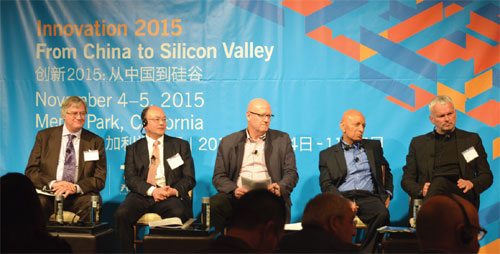Entrepreneurs gather for Silicon Valley brainstorm
|
From left: Richard Dasher, executive director of Center for Integrated Systems at Stanford University; Wang Zhen, vice-president Shanghai Academy of Social Sciences; James McGregor, chairman of APCO Worldwide China; Anil K. Gupta of University of Maryland; and Wilhelm Oehl, principal of Eight Inc Apple Design Team, joined a panel discussion called "Innovation 2015: From China to Silicon Valley" held Thursday by Asia Society and Tianjin Binhai Hi-Tech Industrial Development Area in Menlo Park, California. Lia Zhu / China Daily |
Leading entrepreneurs, business executives and policymakers from the US and China gathered on Thursday in Silicon Valley to brainstorm about the role of innovation in their economies.
Innovation 2015: From China to Silicon Valley was held by the Asia Society in partnership with the Tianjin Binhai Hi-Tech Industrial Development Area in Menlo Park, California, to get expert analysis, explore best practices and get the latest business intelligence on the future of innovation and entrepreneurship in China and the United States.
Silicon Valley companies took advantage of technological innovation to sustain growth amid global competition, and China is using innovation to reach the frontier of technology, Anil K. Gupta, Michael D. Dingman Chair in Strategy and Entrepreneurship at the University of Maryland, College Park, said during a panel discussion.
Entrepreneurs around the world are drawn to Silicon Valley for its unique ecosystem of business, inventors, investors and policymakers, said Wang Zhen of the Shanghai Academy of Social Sciences.
Many big Chinese enterprises had set up R&D centers in Silicon Valley because of the supply of talent and mature technologies, and China also has made strenuous efforts to adapt its financial and policy environment to support innovation among entrepreneurs, he said.
"Chinese universities and research institutes are never more open than now," Wang said. "The professors and researchers are encouraged to start their own companies, and the achievements are attributed to individuals or teams."
The Chinese government has been adjusting its financial policies, such as facilitating overseas investment in innovative technologies and cutting taxes for venture capital investment, and it has raised special funds and instituted policies to attract overseas talent, Wang said.
"As far as I know, no other country has made greater efforts to push innovation than China," he said.
"For the last 10 years, the Chinese students at Stanford University have returned to China immediately after graduation," said Richard Dasher, executive director of the Center for Integrated Systems at Stanford University. He encourages students to be aware of the investment and market opportunities in China.
According to a recent report by the McKinsey Global Institute, The China Effect on Global Innovation, China faces an innovation imperative. As labor-force expansion and heavy capital investment ease, innovation will need to contribute up to half of GDP growth by 2025, or $3 trillion to $5 trillion per year.
liazhu@chinadailyusa.com



















